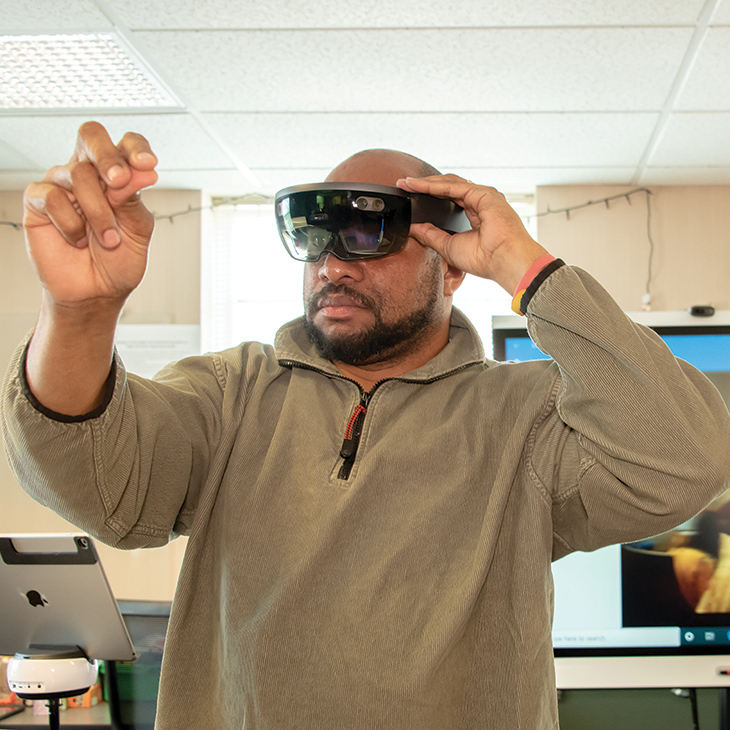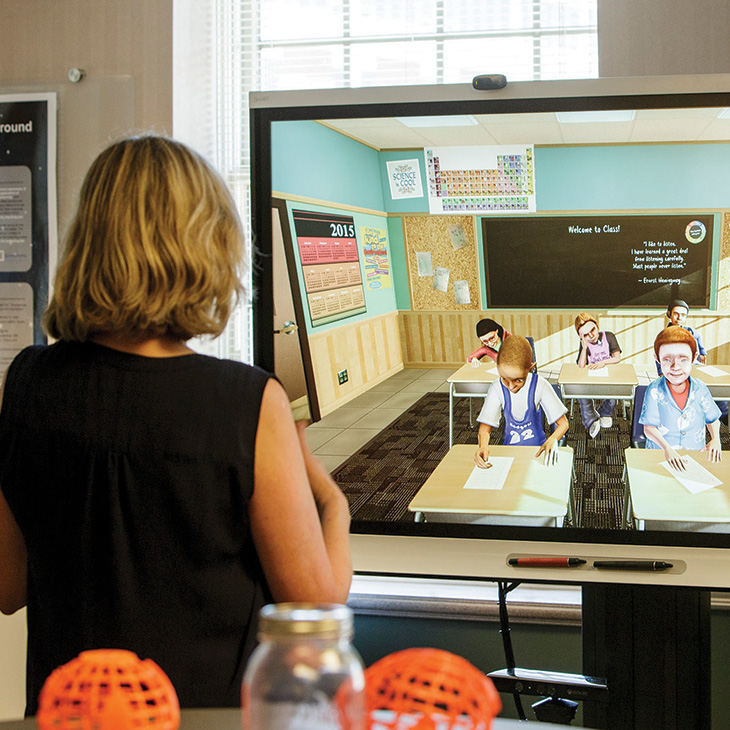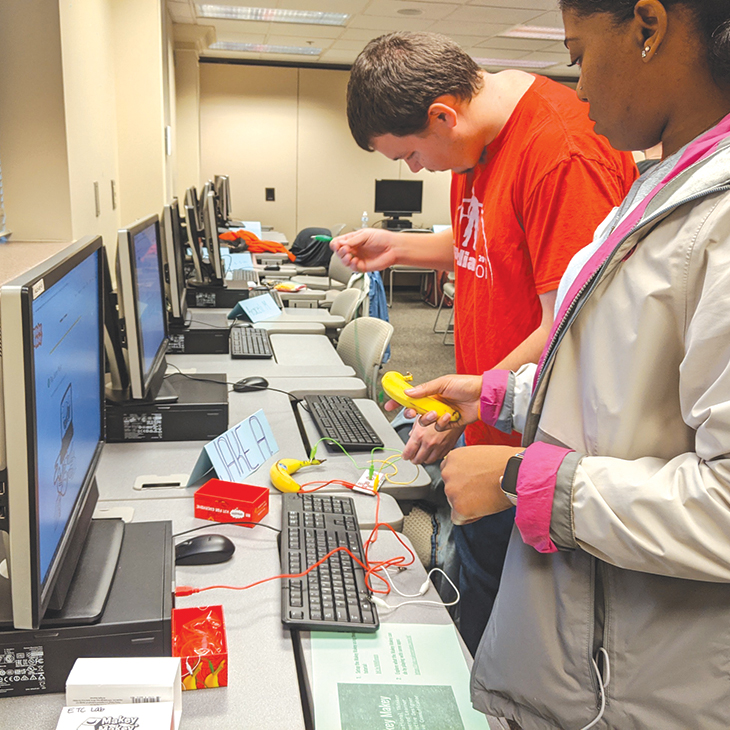
Ahead of the curve: How OSU prepares aspiring teachers for the digital classroom
Thursday, December 17, 2020
Once a novelty, online instruction has become ubiquitous in the age of COVID-19. While some universities are playing catch-up with curriculum for aspiring K-12 teachers, Oklahoma State University remains ahead of the curve.
When Kalianne Neumann, an assistant professor of educational technology now in her third year of teaching at OSU, first came to campus, she set her sights on overhauling the Applications of Educational Technologies course. Her goal: Empower student teachers to leverage technology in a way that is effective and helps students learn with technology rather than from it.
During the fall 2020 semester, the projectbased class was taught entirely online, serving as a platform for instructors to model effective technology integration.
“As someone who lives in this field and has been teaching online since 2011, I want to make sure students have a good impression of [online teaching] so they understand what it could be,” Neumann said.
“In that class, instructors can all see changes in the students. You can see them being really hesitant about teaching with technology until the end, and then they get pretty excited about it, and you can see their thinking change.”
Kaitlyn Robison, a recent secondary education graduate and middle school teacher in Choctaw, Oklahoma, said OSU prepared her well for online teaching, long before COVID-19 was a concern.
“It’s one thing to use technology as a student, but learning how to effectively implement it in your own classroom is a challenge,” she said. “In my social studies education courses, Dr. Shanedra Nowell, the professor of social studies education, did an excellent job demonstrating various technological tools available to use in the classroom — many of which I am planning to use this school year.”
Robison was one of nearly 170 OSU student teachers in the middle of her spring studentteaching internship when schools across the state began shutting their doors. With OSU, she knew she had a lifeline.
“Professors in the College of Education and Human Sciences provided many resources and ideas to keep students engaged in learning as well as ways to check in and see how students were doing,” she said. “One of the biggest challenges of online teaching, in my opinion, is building relationships with students. I know from the many online classes I took during my college career just how difficult that is. However, I feel prepared, because of my time at OSU, to successfully build meaningful relationships with my students, even if it has to be done from afar. While it will look quite different than if we were in the classroom full-time, I have been given a number of resources and ideas to get to know my students.”
Like Robison, first-year teacher Ryann Gerdes said she feels well-prepared to lead a digital classroom. The biggest challenges, she said, aren’t the tools and tech, but keeping students engaged from a distance, especially when anxiety and uncertainty seem to permeate everything.
A secondary social studies education graduate, Gerdes said her OSU experience equipped her to do just that. Now teaching freshman Oklahoma history at Edmond North High School, Gerdes said she’s leaning on the digital strategies she learned at OSU to help bring history to life.
“When you are teaching history, you want in-person discussion of events and different viewpoints on situations in order for the students to understand how a particular event happened and, most importantly, why the event happened,” she said. “Through online learning, I am able to find different sources of information to give students so they can have an exciting outlook on history.”

Still, Gerdes said there’s something exciting about teaching history while a significant chapter of history is unfolding.
“Never would I have thought this was something that I would face in my career, which also makes it exciting because in the future students will be learning about this in their history classes,” she said. “Not only am I trying to learn the best way for me to teach information as a firstyear teacher, now I have to have the flexibility of learning how to teach online during COVID. But it’s not only affecting me; it also affects every single teacher, whether they have perfected their teaching style for 30- to 40-plus years or they are beginners like me.”
Despite the challenges of juggling online and in-person teaching, Robison said there’s a silver lining to starting her career now.
“Entering the teaching field at this time comes with many emotions and fears,” she said before the start of the fall semester. “There is so much stress that already comes with being a first-year teacher, so when you add in the pandemic situation, it becomes far more stressful. Instead of just the normal stresses of being a traditional first-year classroom teacher, I am now juggling teaching three completely different groups of students. I am responsible for creating meaningful lessons for in-person classes, virtual days, and the 100 percent virtual learners, all while knowing that everything could change tomorrow.
“While it definitely seems overwhelming to be a first-year teacher during the 2020-2021 school year, I am almost thankful that this is occurring at the beginning of my career, rather than later down the line. While I do have expectations of what I thought my first year would look like and what teaching would be like, I am starting from scratch.”
OSU’s curriculum for aspiring teachers cuts across all manner of disciplines and subject matter and addresses specific challenges. Recent graduate and OSUTeach program participant Madelin Kant is now a teaching assistant in a junior-level forest ecology course at Oregon State University in Corvallis, Oregon, where she’s pursuing a master’s degree. She said online teaching is particularly challenging. For her, preparing for the digital classroom means finding creative solutions for engaging students with science from a distance.
“My experience with OSUTeach equipped me with many creative and innovative methods of incorporating technology meaningfully into the science classroom,” she said. “My field experience instructors, from the very first OSUTeach course, modeled how to successfully utilize online platforms to engage students and create positive learning environments by teaching us — the future teachers — with these online practices. My instructors at OSU modeled a diverse array of technology-based practices to allow us to experience numerous options — such as virtual bulletin boards for class discussions, science experiment computer simulations, video responses for student assessment and even creating computer-generated comic strips used as reading reflections.”
In the spring, Kant got her first earnest taste of teaching from a distance when she helmed a ninth-grade biology class.

“I reflected back to my previous OSUTeach courses to implement different online-based activities to continue to keep students interested and interacting,” she said. “As a science educator who has been trained to teach biology through student inquiry and hands-on practices, there is a major obstacle to overcome when transitioning to an online-based classroom. This is what I found most difficult, as I think there is power in students doing science and not just talking about it. I think online student-manipulated science simulations will be most helpful in supplementing this vital component of science education in our current pandemic situation.”
Professional Education Unit Director Robin Fuxa said it’s no surprise these teachers are finding success in their digital and hybrid classrooms. She feels OSU is particularly strong in preparing students to teach digitally. But teaching is about more than just lesson plans, facts and figures, especially during a pandemic.
“We also have a very strong researchbased pedagogical focus across programs,” she said. “Our candidates are exceptionally prepared to consider learners’ strengths and needs (social, emotional, academic) and build on those. We are offering a traumainformed pedagogy session to our interns starting this fall and did faculty-wide professional development on traumainformed teaching last year as well. Last but certainly not least, we work very hard to prepare teacher candidates to advocate for equity in their professional lives, in their own teaching and beyond.”
